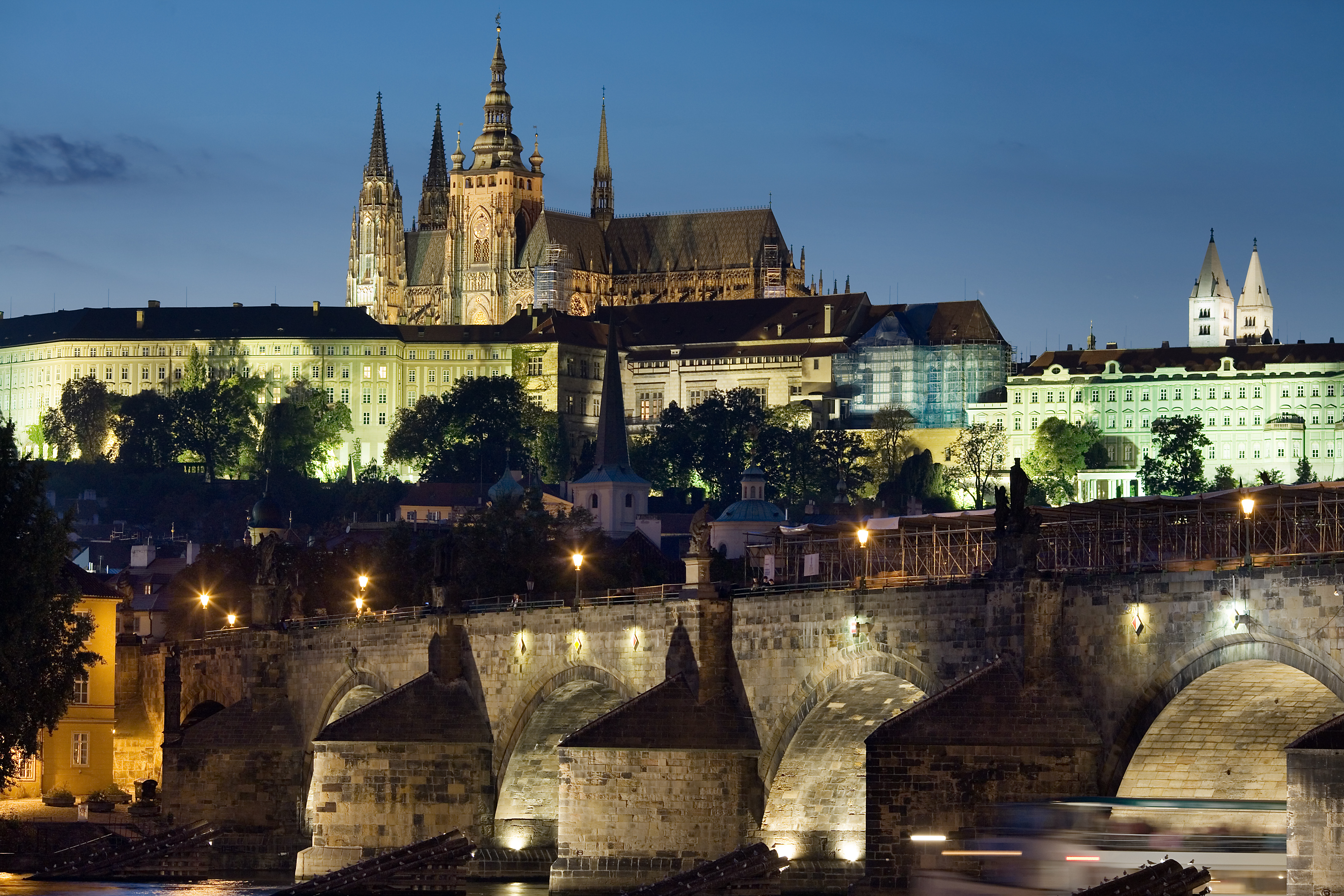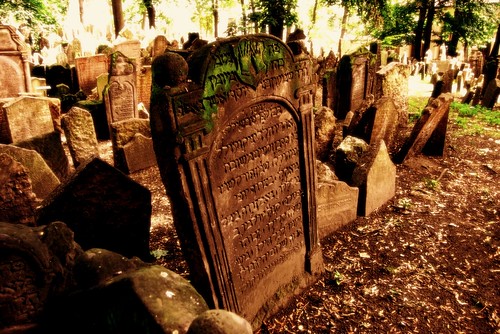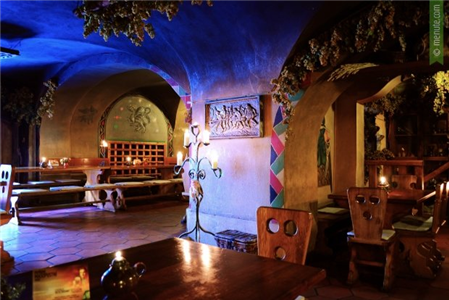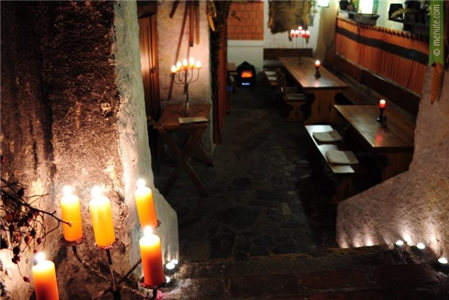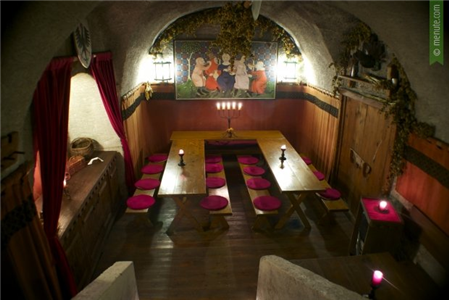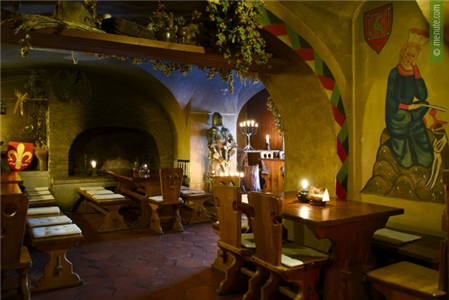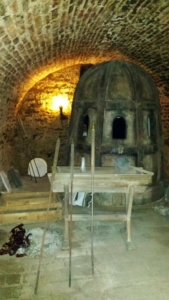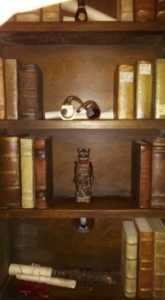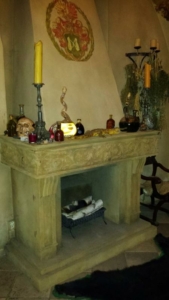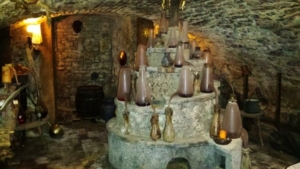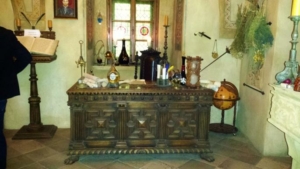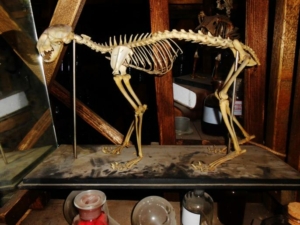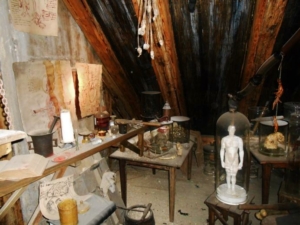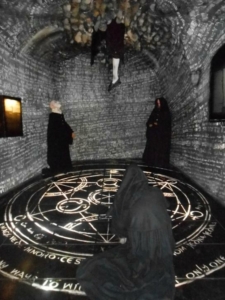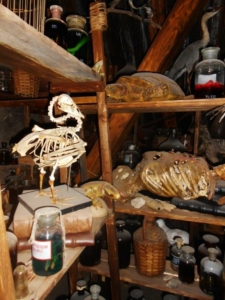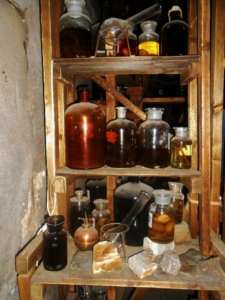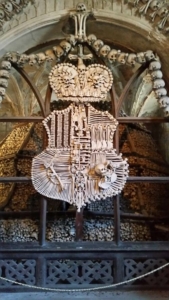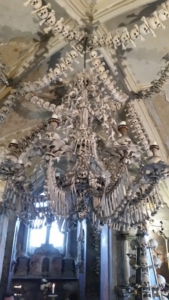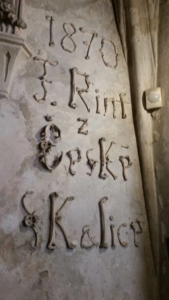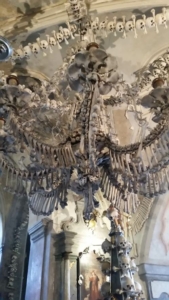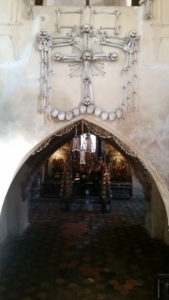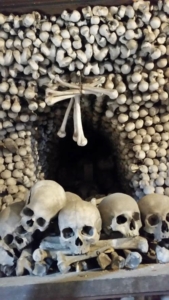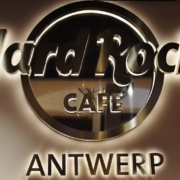GRIMM in Prague
As far as a trip to a dark and mysterious city goes, Prague sure can hold up it’s own. Shrouded in mystery and history, we want to take you into the heart of the city and show you why Prague should be your next metal vacation. Over the course of a week, Wrok and Valerie from our editorial team, walked through dimmed-lit streets following the sound of metal to find some hot spots and meet the locals.
[tabby title=”The City”]
But before we go into the (literal) underground in our quest for some good tunes, a first timer tourist in Prague should stay above ground and take in the beauty that is the city itself. As long as you keep to the center, every building is a little archaeological masterpiece. Be it Romanesque, Gothic, Baroque or even Art Nouveau, so many buildings that aren’t even part of the main attractions of Prague, demand a moment to be gazed at. Combine this with some old fashioned street lights and cobblestone roads, and you’ve got yourself a magical walk as though you were walking in a bit of history. This in despite of the great fire of 1689, which devastated the city. If one looks closely, you can see which quarters were more or less damaged by the fire, since the rebuilding following this catastrophe introduced the Baroque beauty of the city, host to many palaces, churches and gardens.
Both romantic, magical but also dark, every day in Prague offers a new opportunity to take scenic walk back in time… for about five days. After that, I felt like I’ve seen the most of it though I’m sure I missed tons of beautiful little secret spots that aren’t so easy to find for a tourist. Which brings me to another point. With more than 2500 citizens in a square mile, you would think to meet a lot of the locals. That’s where you’re wrong, the amount of tourists is not only astonishing, but simply frustrating. The locals you do find on the streets either work at a tourist-oriented activity, or hand out flyers to some strip club (avoid the people in red coats, they’re assholes and pushy). It’s not until you deviate from the popular streets and find yourself a little bar, where you can listen to the tales of people who live there.
First of all, let’s go over some sites you must see while visiting!
[tabby title=”The Sights”]
Charles Bridge
The oldest remaining bridge in town attracts too many tourists, but is still the nicest way to cross the Vltava river, but wasn’t the first one around. Damaged by floods in the 14th century, the Judith Bridge had to be replaced by what used to be called the Stone Bridge. It’s wasn’t finished until the first years of the 15th century and became known as the Charles Bridge as late as 1870. Over time a total of thirthy statues were carved and placed along the bridge, the most famous being the statue of Saint John of Nepomuk.
While walking by day from one gaurdtower to another, you can revel in small shops and sketch artists trying to earn some extra bucks, but at night the magic happens as you can see both sides of the city in an eerie darkness, lightened by just a few sources throughout the streets.
Prague Castle
It’s quite a hike to the top of Prague Castle, but the view is worth it! Being over a millennium old, you might wonder what remains from the original building. After spending a few hours roaming the immense area, I would think that everything has been renovated or replaced over time, but it is still an impressive piece of history to walk through.
If you find yourselves nearing the top, the touristic pubs and shops start to fade away and at the end, you’ll have a great view of the botanical gardens and the rest of the city. I wish one could visit it by night, but the most quaint little district within castle walls, which leads to the most impressive panorama, is only open during daylight hours at a small fee.
Jewish Cemetery
I think we all heard the story of the Golem that came to live in Prague using magic. Visiting this cemetery immediately brought up that story with the rabbi’s grave being hidden among the tombstones. Rabbi Judah ben Bezalel, or Rabbi Löw for short, is buried among hundreds of others, cluttered in a compact space that symbolizes the dark and grief ethos Prague holds its own. If you are interested, you can visit the museum next to the cemetery for a nominal fee during daylight hours, which portraits how live used to be in this oldest of Prague’s quarters.
Old Town Square
After spending almost a week in the city, I never found a new town square, or maybe they simply had another and never called it that way. It matters not because this is where you’ll want to position yourself most of the time. Centrally located and filled with neat little pubs or overly priced restaurants, this is one of the best landmarks to use while wandering the city streets.
Surrounding the squares are many segways (no, I’m not joking, it’s like a plague…), annoying men in red dresses trying to get you to strip clubs (worse than the aforementioned plague), and tons and tons of tourists. But if you can look past that and maybe punch the billionth guy who tries to sell you something, you’ll see some pretty amazing sights. Most notably the astronomical clock which houses it’s own little show daily like clockwork (heh heh heh).
Overseeing the plaza is a rather blackish church, called the Church of Our Lady before Týn. I don’t know what came after Týn, I’m not into visiting churches too much, but whilst eating at the rooftop of the Terasa U Prince (which I can only recommend for the view since it’s food is deplorable and I came too close to throwing our server from the balcony) it instills a feeling of a dark history to which one can only fantasize about.
[tabby title=”The Bars”]
U sedmi Švábů
(Jánský vršek 241/14, Praha)
Crossing the river, we enter the oldest part of Prague. At the foot of the castle lies a little pub which will offer a great experience when visited. I’m talking about U sedmi Švábů, a medieval pub/restaurant whose interior and food will enchant you. The name roughly means “the seven Swabians”, derived from a fairytale from the Brothers Grimm (which I only found out while writing this article…). In any case, this establishment already lures you in with it’s medieval entrance, and when you pass the wooden doors, a few chandeliers and a lot of candles invite you to sit down and have a drink.
Once I had a drink in hand, I started looking around to enjoy the scenery. The walls look very old and most decorations have a real authentic feel to them. A fireplace, some armor and weapons en dried plants, everything fitted together nicely. It had a warm atmosphere which I could enjoy for hours. I started talking to the bartender, Vladimir, who showed me the closed off part of the pub: the cellar. I’ll let the pictures speak for themselves, I for one wanted nothing more to bring some friends, a barrel or two of the finest ale around and start drinking and singing! I just hope I won’t get so drunk I’ll start seducing the witch statue behind bars.
Necropolis
(Velehradská 18, Praha)
If you’re staying in the city center, getting to Necropolis might be a bit of a hassle, and getting back might be even worse (public transport is only available until midnight), but it is worth it. By far my best time in Prague was at Necropolis’ counter! Hidden away in a cellar in the middle of a residential area, one can find the red walls housing a literal underground metal bar. Under the watchful eyes of a skeleton, some plush spiders and a painting of hell, a short visited that eventually lasted until morning began.
Even though the pub isn’t in the center of the city, the place was full. Everybody seemed to know everybody in this tightly knit web of friends, making the first beer a bit awkward. Having many who the fuck is that looks granted my way, we started talking with the bar owner Michal. Soon after that, everybody welcomed us with open arms. He showered us with goodies and beer, being enthusiastic having some people from strange faces over. He took it over about two years ago, gathering a nice group of people who spend their weekends here without exception.
When I said the people here were friendly, I’m making the understatement of the year. Once the ice has been broken, everybody starts talking to you and the beer keeps flowing (I can’t remember how many I had, just that I had difficulty buying a round myself). After the beer, came Medovina, a nice mede gentle to the lips. Then came the shots, many many shots. Throughout all the drinking, conversations became more interesting.
From all the people there, we also met another Michal, singer of the band 7Sins of Surviving. After introducing his band and inviting us to a concert (which we sadly couldn’t attend), conversations started spiraling out of control about politics, war, philosophy, everything your heart could desire. People started joining in, beautiful people, intelligent people, party people. This simply was our best night of the whole trip and I cannot stress enough how you should not miss out on this pub!
Necropolis, you guys were awesome! See you soon!
Hard Rock Café
(Malé Námestí 143/2, Praha)
As some of you guys might know, my opinion about Hard Rock pubs all over the world have one of the worst brand names ever. Personally, I would call it Moisturized Gravel Café or something like that, to which the only real amazing this is the interior with many rock ‘n roll and metal memorabilia. I have found, however, the first exception at Hard Rock Cafe Prague and am needed to renew my opinion of the brand, or at least in the case of this particular establishment.
Yes, the interior, design, decorations, they were amazing, but the most mindblowing part was the fact that I didn’t hear hip hop or techno like we would in Hard Rock Café Brussels, but real rock and metal! I can personally testify hearing song of Kansas, Metallica, Soulfly and many more. In hindsight, this might not come as a surprise sing rock and metal music seem more common among the general public here than it is in Belgium, but it still came as a very pleasant surprise to me.
The pub itself is very large, larger than most I can remember visiting in my life. Three stories tall with a a chandelier in the shape of a Gibson Les Paul hovering over the main bar in the center of the ground floor, immediately take away your breath. The ground and first floor house the main bar facilities, while above that you can find a restaurant (renowned by the locals for their burgers, but at the time I got there I was too late to grab a taste), and a private area that one can rent for parties. Even though those parts were closed, local manager Michal allowed me free roam to take in all the fancy relics. With some beer in my mouth and good stories in my ear, the must-see artifacts are without a doubt ZZ Top’s guitar on display and a motorcycle owned by Aerosmiths very own Steven Tyler.
[tabby title=”The Museums”]
Museum of Alchemy – Speculum Alchemiae
If you read about the history of Prague, you’ll soon encounter the city’s tales about alchemical laboratories and dark medieval practices. We found out about two achemical museums and went to visit them both.
The first one, situated right in the old city center, reveals Rudolf II’s original alchemical laboratory from the 16th century, underneath the street level, hidden from unwanted glances of passers-by.
Immediately we were so fascinated by the bottles of elixirs, the dried herbs on the ceiling, other rarities and the overall magical atmosphere that wanted to participate with the guided tour, which took half an hour. The guide told us all about the activities of alchemists in Prague in the late medieval and early modern times, when science and mysticism were closely linked, and researchers were looking for a ‘higher purpose’ and ‘harmony of the spheres’, which could help them discover the secrets of nature.
She also revealed interesting facts about the history of this particular house. The newly opened alchemical laboratories were discovered during the reconstruction of one of the oldest historical buildings in Prague on the street Haštalská number 1 in 2003. This building is listed by UNESCO and by miracle this one has been preserved after the demolition of the Jewish quarter at the end of 19th century. The first written references about the stone area at the current location of the museum dates back to year 900 AD which means that this house is probably the second oldest building in Prague. It is also located near the most important European trade route Grand Via, which ran across whole Europe to the Far East. Merchants probably used to come to this house and they always brought exotic goods and information with them. There were discovered alchemical workshops under the building and also underground tunnels that connected the three most important places in the city – Prague Castle, the Old Town Hall and Barracks.
According to written reference there was a herbal pharmacy in the 15th century, in which alchemists sell their potions and elixirs, later a place where the Emperor Rudolf II. established his alchemical laboratory in the 16th century, and now belongs to one of the few preserved houses during the redevelopment of the Jewish Quarter, which took place in Prague at the end of the 19th century. This incident is covered with mystery because no one ever reliably explained why this building was removed from the reconstruction plan.
So if you’re interested in a little gloomy piece of the city’s history, I strongly suggest you take a guided tour at the Speculum Alchemiae and take a walk underground tunnels beneath the street level. On their website the museum announces for 2016 a new sight-seeing tour called The Magical Triangle, from the museum to Vyšehrad to the Prague Castle, which is probably worth trying out!
Museum of Alchemists and Magicians of old Prague
The second museum, Museum of Alchemists and Magicians of old Prague, is situated on the other side of the river, near to the city castle. As it was already late in the evening when we arrived at the museum, the staff informed us that we could participate in the last guided tour of the day, but unfortunately it never came through. As we were already there, we decided to take a look around without an guide, and later on have some beers in the Kellyxír pub next to the museum.
The museum has three separate parts you can visit. On the ground floor, you can find prepared information about alchemy and alchemists by leading experts including professors of Charles University. There is also a variety of interactive exhibits and you can enter the mysterious room of the Faust’s house, where you will find stories of alchemists and magicians of old Prague.
The second, and for me the most interesting part, consists of the original attic of Edward Kelley from the 16th century. After you climb up 60 steps of one of the oldest wooden staircases in Prague, which was reportedly designed by Kelley himself, you will enter the laboratory of the famous alchemist. The first laboratory room serves both as a storage, a library, but also as a waiting room for those who want to enter the lab. The second room is a separate laboratory, where you can find the creation of homunculus, you will see furnaces, bowls and bottles and a lot of experimental animals and other rarities.
The last part, but certainly not the least, is the Alchemical Lab Pub Kellyxír, where the ceiling is covered in flasks and recipes for elixirs. Amazingly this place wasn’t crowded by a lot of tourists, the staff was very friendly and we could enjoy a good beer at a very reasonable price from their funny alchemical menu. Definitely worth a visit!
[tabby title=”Kutna Hora”]
As seen in the video clip Darkness Within from Machine Head, there is a church consisting mostly out of human remains. Well, it’s not in Prague, but rather an hour trainride away from Prague in a small village called Kutna Hora. The town itself is just under a millennium old and most notably known for their silvermines back in the day, which they named Kuttenberg. The name, which might amuse some of our dutch readers, is actually derived from the monk’s cowls (kutten), or from the old Czech word for mining (kutání). These mines were property of the Sedlec Monastery, which gained a lot of territory over the decades.
For centuries, Kutna Hora competed with Prague both economically, politically and culturally. It developed at an amazing rate and at the start of the Hussite Wars in 1419, it was the favorite residence of many Bohemian kings second only to Prague. It is in those Hussite Wars, which came just after the Black Death, that thousands were buried in the abbey cemetery, which had to be greatly enlarged. It was during this time that a Gothic church was built in the center of the cemetery with a vaulted upper level and a lower chapel to be used as an ossuary for the mass graves unearthed during construction.
From 1511 until the day he died, a half-blind monk was tasked with exhuming and stacking bones in the chapel, but it wasn’t until the late 19th century that a woodcarver called František Rint was employed to put the bones in four bell-shaped heaps. Employed by the Schwarzenberg family, a Bohemian and Franconian aristocratic family, Rint also build their coat of arms out of human remains, as well as signed his art using the smaller bones of our body.
The result can be visited for a nominal fee in the Sedlec Ossuary, in a suburb of Kutna Hora. It is estimated to house between 40 000 and 70 000 bones, all of them used in a macabre sense of art. Appart from the four heaps, coat of arms and Rint’s signature, one can gaze in awe at an enormous chandelier of bones in the center with garlands of skulls draping the vault. Staring down the holes within the heaps, one can truly find the darkness within.
[tabbyending]
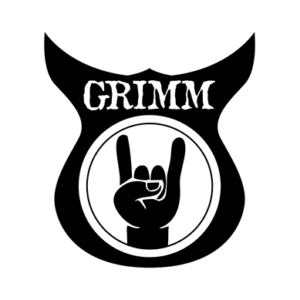
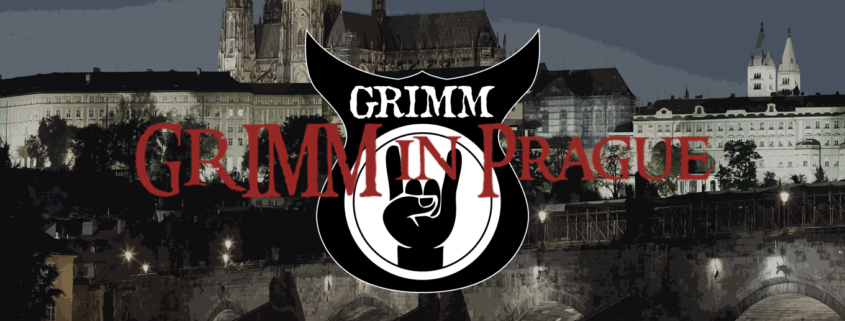
.jpg)


